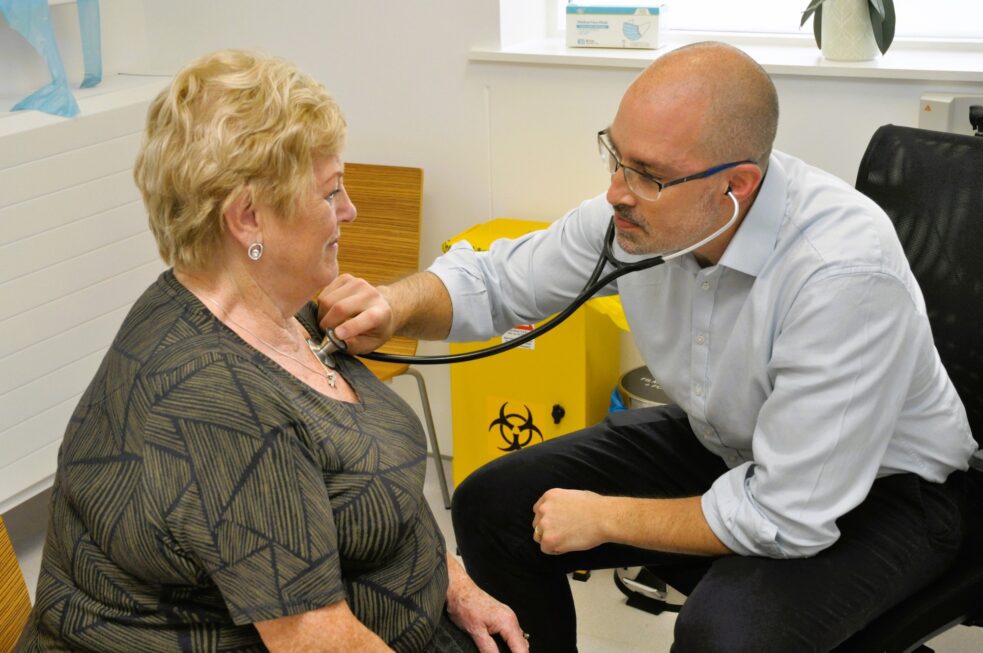On January 16, 2025, global experts convened to unveil and discuss a new clinical definition of obesity, which they describe in a new report: Definition and Diagnostic Criteria of Clinical Obesity. This updated framework — the result of years of meetings and debates among members of The Lancet Diabetes & Endocrinology Commission on Clinical Obesity — redefines obesity as a disease in its own right. It also explains how individuals should be diagnosed, using criteria such as direct measurement of body fat and organ function quality.
“The prevalence of obesity is increasing in every single region of the world,” said Richard Horton, editor in chief of The Lancet, during a kickoff to the in-person and virtual event. “We have to be clear about the problem we are addressing,” Dr. Horton emphasized, noting that this is why the Commission focused on establishing clear definitions and diagnostic criteria for both preclinical and clinical obesity.
While the Commission pursued clarity in its stated goals, one critical element has yet to be discussed thoroughly: implementation. During the live-streamed event, there was limited guidance on how healthcare systems, doctors, and policymakers should adopt this new definition in practice. Until concrete plans are drawn, the real-world impact of these updated criteria — and whether they will meaningfully improve diagnosis and treatment — remains to be seen.
Defining Obesity as a Disease Was ‘Our Responsibility,’ Say Commission Experts
The Commission was established for two main reasons, explained Francesco Rubino, M.D., Chair of the Commission and a professor of metabolic and bariatric surgery at King’s College London. The first was to address the ongoing controversy surrounding classifying obesity as a disease. “The very fact that a disease would be a matter of opinion sounded a little bit strange,” noted Dr. Rubino. “Diseases are not supposed to be matters of opinion. They’re supposed to be matters of fact.”
The second reason, he said, is that medical institutions have been lobbying for clearer diagnostic criteria for some time, even turning to political organizations for help.
The recent obesity medication boom likely also played a part in the creation of these new guidelines. Commission member Stefan Bornstein, M.D., Ph.D., of University Hospital Carl Gustav Carus, shared that he has felt significant pressure from patients demanding prescriptions. He noted that requests for GLP-1 medications, such as Wegovy and Ozempic, have come not only from patients but also from friends, family, politicians, and even colleagues.
“[They were saying], ‘we want these new medications. We know that you can get slim,’’’ he said. Working with the commission to reflect on the definition of obesity ultimately helped him talk to his patients about their individual risk factors to determine appropriate interventions.
“There was obviously a need for the medical profession to step up and say, ‘this is our responsibility,’” when it came to defining the disease, added Dr. Runino. Reaching a consensus on the definition of obesity is also essential for establishing a clear standard of care.
The event lasted about four hours and included presentations, panel discussions, and Q&As that provided opportunities for stakeholders including doctors, policymakers, and patient advocates, to ask questions.
Here’s what was discussed.
As a Diagnostic, BMI Was Unclear and Unhelpful
One of the key things experts agreed on during the commission’s presentation is that Body Mass Index (BMI) is an inadequate measurement of health.
A ratio of weight to height, BMI has long been used to estimate both the prevalence of obesity and overweight, and to identify those conditions in individual patients. However, experts have been raising the alarm for years that the measure is imprecise and not designed to be used for a diagnosis — and Commission members unanimously agreed that BMI alone is inadequate to predict how much fatty tissue a person may be living with.
Clearer Obesity Criteria: Fat Around the Waist and Organ Dysfunction
With BMI now considered useful only as a screening tool, Commission members explained that it is more accurate to define obesity as a condition involving excess body fat — particularly around the midsection. Fat around the midsection is often considered the most dangerous kind of fat, because it can wrap around vital organs, such as the heart, pancreas and liver.
The commission highlighted that the simplest way to measure midsection body fat is by using a tape measure to assess waist circumference.
According to the commission, a person has enough excess fat for an obesity diagnosis if they have any two of the following proposed measurements:
- A waist circumference equal to or greater than 102 centimeters for men or 88 centimeters for women
- A waist-to-hip ratio greater than 0.9 for men and 0.85 for women
- A waist-to-height ratio greater than 0.5 for all
For better accuracy, a dual-energy X-ray absorptiometry (DEXA) scan can provide a direct measurement of an individual’s body fat percentage, but it’s more practical to start with a tape measure.
“Ultimately, when waist circumference is elevated, it doesn’t make any difference what your BMI is,” explained Robert Eckel, M.D., a professor of physiology and biophysics at the University of Colorado Anschutz, but BMI paired with one of the waist-focused measurements above can also confirm excess body fat, according to the Commission’s report.
Agreeing that excess fatty tissue around the waist is often directly linked to organ dysfunction, the Commission noted that it is important for physicians to determine whether a patient’s excess weight is contributing to any dysfunction present.
For instance, shortness of breath can stem from various causes unrelated to body fat. However, if a healthcare provider determines that a person has excess fat and that this fat is likely causing at least one symptom of organ dysfunction (in this case, shortness of breath), the person would be diagnosed with clinical obesity. An important goal of treating their obesity would not just be losing weight, but improving their shortness of breath.
Organ dysfunction can include symptoms such as:
- Shortness of breath caused by obesity’s impact on the heart and lungs
- Joint stiffness
- A cluster of three metabolic abnormalities (hyperglycaemia, high triglyceride levels, and low HDL cholesterol levels)
- kidney problems
- Central nervous system disorders (causing symptoms such as vision loss or headaches)
- Breathing problems such as sleep apnea
- Cardiovascular problems such as heart failure, atrial fibrillation, recurrent deep vein thrombosis, elevated arterial blood pressure, or pulmonary artery hypertension
- Non-alcoholic fatty liver disease
- Urinary incontinence
- Reproductive conditions such as polycystic ovary syndrome or male hypogonadism
- Swelling of the lower limbs that causes pain or limited range of motion
Preclinical Obesity: A Novel Approach to Diagnosis
The Commission also proposed that preclinical obesity become a regular term: Once a person is identified as having obesity, their doctor should differentiate between preclinical and clinical.
Preclinical obesity should be noted when there is no current organ dysfunction, but a person’s overarching obesity condition likely puts them at risk for organ dysfunction in the future. In many cases, treatment plans for individuals with preclinical obesity will not need to be as aggressive as they would for someone already experiencing organ dysfunction.
One of the main differences between the treatment of preclinical and clinical obesity, the Commission noted, is the treatment goals. If you have preclinical obesity, the main goal of your treatment will be to reduce fat. In contrast, if you already have organ dysfunction, your healthcare provider should be focused on improving those functions.
For example, if you are diagnosed with clinical obesity and one of your symptoms is shortness of breath, your healthcare provider may recommend a combination of medicine and exercise that would help strengthen your heart and lung function as well as help you lose weight.
Another critical characteristic of obesity noted in the Commission’s report and presentation is the fact that experts now believe it is a chronic, relapsing disease, “because remission does not necessarily mean cure,” noted John Wilding, D.M. (Doctor of Medicine), a professor of cardiovascular and metabolic medicine at the University of Liverpool.
Dr. Wilding emphasized that individuals with obesity who lose fat remain at risk of regaining it without ongoing care, which means that many people diagnosed with obesity may require continuing treatment (such as lifestyle modifications, therapy, or medication) on a long-term or even indefinite basis. This lifetime treatment is ”something healthcare systems need to start acknowledging,” he added
Challenges in Adopting a New Obesity Definition
The Commission emphasized that its purpose thus far was only to solidify the definition and diagnosis of obesity, not to outline treatment strategies appropriate for patients with specific conditions or levels of risk.
They did, however, call on professional medical organizations and academic institutions to begin the formidable task of implementing educational initiatives and outreach, such as short training programs and informational flyers, to encourage doctors to use the new criteria for both diagnosing and measuring treatment progress of obesity.
Ruminating on the challenges that may arise in translating these recommendations into practice, Jonathan Valabhji, M.D., a professor of metabolism, digestion and reproduction at the Imperial College London, observed that the burden will likely fall on already overextended healthcare workers.
“It is generalists, not specialists on the whole, who will have to apply what we’ve described to populations,” Dr. Valabhji explained to the group of healthcare experts, patient advocates, and other concerned individuals attending the event. “Empowering the generalists to run with what we’ve arrived at today will take tools, educational components, and buy-in from many people who are already inundated with their daily workload.”
As Commission members signed off, the question of where that necessary support and education they described would come from — and how it would be funded — remained unanswered.
How You Can Use The Commission’s Findings to Advocate for Yourself
While the Commission concluded without addressing the implementation of their new criteria, individuals concerned about obesity — or obesity-related organ dysfunction — should feel empowered to discuss these updated measurements and treatment approaches with their doctor. This is especially important for those who believe that BMI alone does not fully reflect their health status.
A range of treatment options are currently available to address obesity directly. Diet, exercise, and lifestyle changes are a valuable starting point, especially since research suggests that while weight loss medications can aid initial weight loss, lifestyle modifications offer long-term benefits.
While GLP-1s and other weight loss drugs continue to make waves, they come with their own set of side effects — some of which are still emerging. Be sure to discuss the risks and benefits of each option for your specific condition with your healthcare provider.
If you are living with extra weight and believe you’re experiencing symptoms of organ dysfunction, such as shortness of breath or joint pain, ask about what kind of relief you might expect from weight loss alone, and whether other options, such as physical therapy, a CPAP machine or other medications, might help you on your journey.






